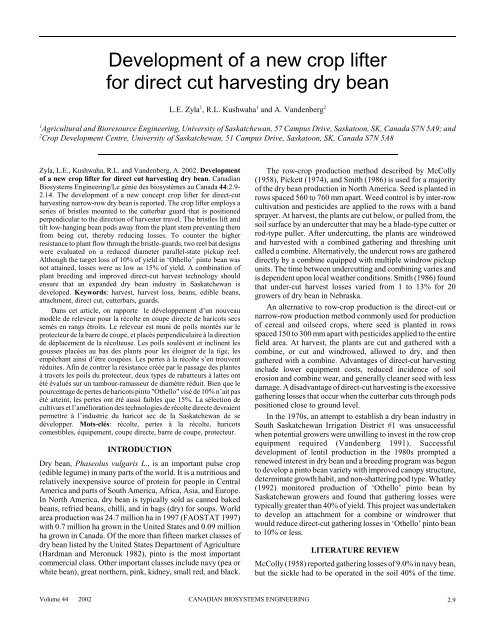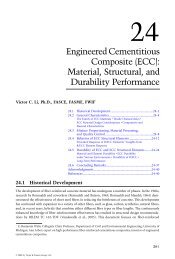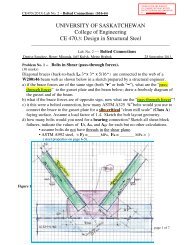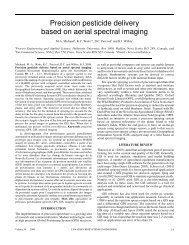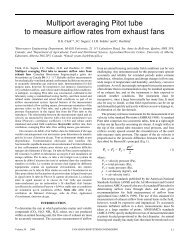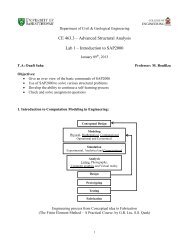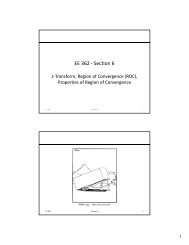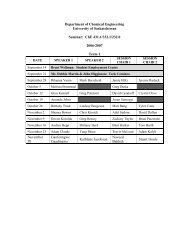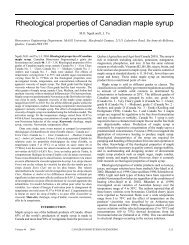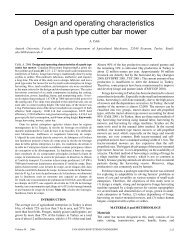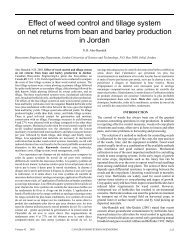Development of a new crop lifter for direct cut harvesting dry bean
Development of a new crop lifter for direct cut harvesting dry bean
Development of a new crop lifter for direct cut harvesting dry bean
Create successful ePaper yourself
Turn your PDF publications into a flip-book with our unique Google optimized e-Paper software.
<strong>Development</strong> <strong>of</strong> a <strong>new</strong> <strong>crop</strong> <strong>lifter</strong><br />
<strong>for</strong> <strong>direct</strong> <strong>cut</strong> <strong>harvesting</strong> <strong>dry</strong> <strong>bean</strong><br />
L.E. Zyla 1 , R.L. Kushwaha 1 and A. Vandenberg 2<br />
1 Agricultural and Bioresource Engineering, University <strong>of</strong> Saskatchewan, 57 Campus Drive, Saskatoon, SK, Canada S7N 5A9; and<br />
2 Crop <strong>Development</strong> Centre, University <strong>of</strong> Saskatchewan, 51 Campus Drive, Saskatoon, SK, Canada S7N 5A8<br />
Zyla, L.E., Kushwaha, R.L. and Vandenberg, A. 2002. <strong>Development</strong><br />
<strong>of</strong> a <strong>new</strong> <strong>crop</strong> <strong>lifter</strong> <strong>for</strong> <strong>direct</strong> <strong>cut</strong> <strong>harvesting</strong> <strong>dry</strong> <strong>bean</strong>. Canadian<br />
Biosystems Engineering/Le génie des biosystèmes au Canada 44:2.9-<br />
2.14. The development <strong>of</strong> a <strong>new</strong> concept <strong>crop</strong> <strong>lifter</strong> <strong>for</strong> <strong>direct</strong>-<strong>cut</strong><br />
<strong>harvesting</strong> narrow-row <strong>dry</strong> <strong>bean</strong> is reported. The <strong>crop</strong> <strong>lifter</strong> employs a<br />
series <strong>of</strong> bristles mounted to the <strong>cut</strong>terbar guard that is positioned<br />
perpendicular to the <strong>direct</strong>ion <strong>of</strong> harvester travel. The bristles lift and<br />
tilt low-hanging <strong>bean</strong> pods away from the plant stem preventing them<br />
from being <strong>cut</strong>, thereby reducing losses. To counter the higher<br />
resistance to plant flow through the bristle-guards, two reel bat designs<br />
were evaluated on a reduced diameter parallel-state pickup reel.<br />
Although the target loss <strong>of</strong> 10% <strong>of</strong> yield in ‘Othello’ pinto <strong>bean</strong> was<br />
not attained, losses were as low as 15% <strong>of</strong> yield. A combination <strong>of</strong><br />
plant breeding and improved <strong>direct</strong>-<strong>cut</strong> harvest technology should<br />
ensure that an expanded <strong>dry</strong> <strong>bean</strong> industry in Saskatchewan is<br />
developed. Keywords: harvest, harvest loss, <strong>bean</strong>s, edible <strong>bean</strong>s,<br />
attachment, <strong>direct</strong> <strong>cut</strong>, <strong>cut</strong>terbars, guards.<br />
Dans cet article, on rapporte le développement d’un nouveau<br />
modèle de releveur pour la récolte en coupe <strong>direct</strong>e de haricots secs<br />
semés en rangs étroits. Le releveur est muni de poils montés sur le<br />
protecteur de la barre de coupe, et placés perpendiculaire à la <strong>direct</strong>ion<br />
de déplacement de la récolteuse. Les poils soulèvent et inclinent les<br />
gousses placées au bas des plants pour les éloigner de la tige, les<br />
empêchant ainsi d’être coupées. Les pertes à la récolte s’en trouvent<br />
réduites. Afin de contrer la résistance créée par le passage des plantes<br />
à travers les poils du protecteur, deux types de rabatteurs à lattes ont<br />
été évalués sur un tambour-ramasseur de diamètre réduit. Bien que le<br />
pourcentage de pertes de haricots pinto "Othello" visé de 10% n’ait pas<br />
été atteint, les pertes ont été aussi faibles que 15%. La sélection de<br />
cultivars et l’amélioration des technologies de récolte <strong>direct</strong>e devraient<br />
permettre à l’industrie du haricot sec de la Saskatchewan de se<br />
développer. Mots-clés: récolte, pertes à la récolte, haricots<br />
comestibles, équipement, coupe <strong>direct</strong>e, barre de coupe, protecteur.<br />
INTRODUCTION<br />
Dry <strong>bean</strong>, Phaseolus vulgaris L., is an important pulse <strong>crop</strong><br />
(edible legume) in many parts <strong>of</strong> the world. It is a nutritious and<br />
relatively inexpensive source <strong>of</strong> protein <strong>for</strong> people in Central<br />
America and parts <strong>of</strong> South America, Africa, Asia, and Europe.<br />
In North America, <strong>dry</strong> <strong>bean</strong> is typically sold as canned baked<br />
<strong>bean</strong>s, refried <strong>bean</strong>s, chilli, and in bags (<strong>dry</strong>) <strong>for</strong> soups. World<br />
area production was 24.7 million ha in 1997 (FAOSTAT 1997)<br />
with 0.7 million ha grown in the United States and 0.09 million<br />
ha grown in Canada. Of the more than fifteen market classes <strong>of</strong><br />
<strong>dry</strong> <strong>bean</strong> listed by the United States Department <strong>of</strong> Agriculture<br />
(Hardman and Meronuck 1982), pinto is the most important<br />
commercial class. Other important classes include navy (pea or<br />
white <strong>bean</strong>), great northern, pink, kidney, small red, and black.<br />
The row-<strong>crop</strong> production method described by McColly<br />
(1958), Pickett (1974), and Smith (1986) is used <strong>for</strong> a majority<br />
<strong>of</strong> the <strong>dry</strong> <strong>bean</strong> production in North America. Seed is planted in<br />
rows spaced 560 to 760 mm apart. Weed control is by inter-row<br />
cultivation and pesticides are applied to the rows with a band<br />
sprayer. At harvest, the plants are <strong>cut</strong> below, or pulled from, the<br />
soil surface by an under<strong>cut</strong>ter that may be a blade-type <strong>cut</strong>ter or<br />
rod-type puller. After under<strong>cut</strong>ting, the plants are windrowed<br />
and harvested with a combined gathering and threshing unit<br />
called a combine. Alternatively, the under<strong>cut</strong> rows are gathered<br />
<strong>direct</strong>ly by a combine equipped with multiple windrow pickup<br />
units. The time between under<strong>cut</strong>ting and combining varies and<br />
is dependent upon local weather conditions. Smith (1986) found<br />
that under-<strong>cut</strong> harvest losses varied from 1 to 13% <strong>for</strong> 20<br />
growers <strong>of</strong> <strong>dry</strong> <strong>bean</strong> in Nebraska.<br />
An alternative to row-<strong>crop</strong> production is the <strong>direct</strong>-<strong>cut</strong> or<br />
narrow-row production method commonly used <strong>for</strong> production<br />
<strong>of</strong> cereal and oilseed <strong>crop</strong>s, where seed is planted in rows<br />
spaced 150 to 300 mm apart with pesticides applied to the entire<br />
field area. At harvest, the plants are <strong>cut</strong> and gathered with a<br />
combine, or <strong>cut</strong> and windrowed, allowed to <strong>dry</strong>, and then<br />
gathered with a combine. Advantages <strong>of</strong> <strong>direct</strong>-<strong>cut</strong> <strong>harvesting</strong><br />
include lower equipment costs, reduced incidence <strong>of</strong> soil<br />
erosion and combine wear, and generally cleaner seed with less<br />
damage. A disadvantage <strong>of</strong> <strong>direct</strong>-<strong>cut</strong> <strong>harvesting</strong> is the excessive<br />
gathering losses that occur when the <strong>cut</strong>terbar <strong>cut</strong>s through pods<br />
positioned close to ground level.<br />
In the 1970s, an attempt to establish a <strong>dry</strong> <strong>bean</strong> industry in<br />
South Saskatchewan Irrigation District #1 was unsuccessful<br />
when potential growers were unwilling to invest in the row <strong>crop</strong><br />
equipment required (Vandenberg 1991). Successful<br />
development <strong>of</strong> lentil production in the 1980s prompted a<br />
re<strong>new</strong>ed interest in <strong>dry</strong> <strong>bean</strong> and a breeding program was begun<br />
to develop a pinto <strong>bean</strong> variety with improved canopy structure,<br />
determinate growth habit, and non-shattering pod type. Whatley<br />
(1992) monitored production <strong>of</strong> ‘Othello’ pinto <strong>bean</strong> by<br />
Saskatchewan growers and found that gathering losses were<br />
typically greater than 40% <strong>of</strong> yield. This project was undertaken<br />
to develop an attachment <strong>for</strong> a combine or windrower that<br />
would reduce <strong>direct</strong>-<strong>cut</strong> gathering losses in ‘Othello’ pinto <strong>bean</strong><br />
to 10% or less.<br />
LITERATURE REVIEW<br />
McColly (1958) reported gathering losses <strong>of</strong> 9.0% in navy <strong>bean</strong>,<br />
but the sickle had to be operated in the soil 40% <strong>of</strong> the time.<br />
Volume 44 2002 CANADIAN BIOSYSTEMS ENGINEERING 2.9
Fig. 1. Early bristle-guard attached to tabletop carriage. Fig. 2. Single-bat design showing belting and bristle<br />
combination.<br />
During <strong>dry</strong> conditions, losses <strong>of</strong> 23.2% were recorded. Gunkel<br />
and Anstee (1962) evaluated a modified row-<strong>crop</strong> head. Rubber<br />
fingers attached to v-belts were operated on an incline to comb<br />
through the vines and lift pods over a reciprocating <strong>cut</strong>terbar.<br />
Two conical, rotating brushes were later added to a similar<br />
device and positioned on each side <strong>of</strong> the row to sweep pods up<br />
vertically. The brushes clogged with plant material during<br />
testing.<br />
Gunkel and Anstee (1962) evaluated a modified snap <strong>bean</strong><br />
harvester. Preliminary results were encouraging, but the<br />
literature did not reveal a continuation <strong>of</strong> the work. A flat belt<br />
puller attachment, consisting <strong>of</strong> two 460 mm wide belts held<br />
together under spring tension, also was evaluated. The belts,<br />
positioned on each side <strong>of</strong> the row, captured <strong>bean</strong> plants and<br />
pulled them from the soil on an incline. Losses were 30% <strong>of</strong><br />
conventional, but the device was not advanced to a commercial<br />
product.<br />
The increasing importance <strong>of</strong> soy<strong>bean</strong> to the United States<br />
<strong>crop</strong>ping scenario provided impetus <strong>for</strong> improvements to <strong>direct</strong><strong>cut</strong><br />
<strong>harvesting</strong> equipment. These included the flexible floating<br />
<strong>cut</strong>terbar (Neal 1978), the narrow-pitch combine <strong>cut</strong>terbar<br />
(Quick and Buchele 1974; Quick and Mills 1978), the integral<br />
flexible <strong>cut</strong>terbar (Bichel et al. 1976), and the row-<strong>crop</strong> soy<strong>bean</strong><br />
header (Bichel and Hengen 1978). Air-jet guards, consisting <strong>of</strong><br />
nozzles positioned in front <strong>of</strong> the <strong>cut</strong>terbar to <strong>direct</strong> seed and<br />
pods into the harvester, were also evaluated (Nave et al. 1972,<br />
1977; Tunnell et al. 1973; Wait et al. 1974; Nave and Yoerger<br />
1975).<br />
Researchers soon began investigating the potential <strong>of</strong><br />
improved soy<strong>bean</strong> <strong>harvesting</strong> equipment in <strong>dry</strong> <strong>bean</strong>. Smith and<br />
Biere (1985) compared the integral flexible floating <strong>cut</strong>terbar to<br />
under<strong>cut</strong>ting and found gathering losses to be 25 and 9.0%,<br />
respectively. Harrigan et al. (1991) reported gathering losses <strong>of</strong><br />
8.3% in ‘Mayflower’ navy <strong>bean</strong> using an integral flexible<br />
floating <strong>cut</strong>terbar equipped with pickup reel and modified air<br />
reel. Comparable losses <strong>for</strong> rod and blade-type <strong>cut</strong>ting were 3.9<br />
and 4.6%, respectively. Zyla (1993) evaluated air-jet guards in<br />
‘Othello’ pinto <strong>bean</strong>. Gathering losses were reduced from 50%<br />
<strong>of</strong> yield <strong>for</strong> the standard equipment to 39% <strong>for</strong> the air-jet<br />
guards.<br />
2.10<br />
MATERIALS and METHODS<br />
Equipment design and laboratory evaluation<br />
Bristle-guard A hand-operated, tabletop carriage was<br />
constructed to study plant characteristics and reduce the number<br />
<strong>of</strong> design parameters. It was noted that a vertical distance <strong>of</strong><br />
approximately 100 mm existed between the tops <strong>of</strong> pods<br />
positioned within the <strong>cut</strong>ting zone and ground level. Taking<br />
advantage <strong>of</strong> this distance, bristles were attached to a <strong>cut</strong>terbar<br />
guard to lift and tilt the lower pods <strong>for</strong>ward, preventing them<br />
from being <strong>cut</strong>, and exposing the plant stem to the <strong>cut</strong>terbar.<br />
Individual <strong>bean</strong> plants were fastened to the floor <strong>of</strong> the carriage<br />
and bristle-guards employing bristles <strong>of</strong> different density,<br />
material, orientation, and length were visually evaluated<br />
(Fig. 1).<br />
An International Harvester Model 93 combine (International<br />
Harvester Co., Chicago, IL), equipped with a 3 m <strong>direct</strong>-<strong>cut</strong><br />
header and a six-bat parallel-state pickup reel (H. D. Hume Co.,<br />
Mendota, IL), was subsequently used <strong>for</strong> preliminary laboratory<br />
tests. Drives to all parts <strong>of</strong> the combine except the header were<br />
disconnected. Mature ‘Othello’ pinto <strong>bean</strong> plants, collected<br />
from a site near Saskatoon, Saskatchewan were fastened to a<br />
conveyance plat<strong>for</strong>m that was pulled under the header to<br />
simulate <strong>for</strong>ward motion <strong>of</strong> the combine. Gathering losses were<br />
determined by collecting the seed from each test and expressing<br />
the mass <strong>of</strong> lost seed as a percentage <strong>of</strong> the total mass <strong>of</strong> seed.<br />
Reel Laboratory tests revealed that the bristle-guards <strong>of</strong>fered<br />
greater resistance to plant flow through the <strong>cut</strong>terbar than<br />
standard guards. To counter this resistance, additional reel<br />
support <strong>for</strong> the plants was needed and three design changes were<br />
proposed. Firstly, the conventional reel fingers were replaced<br />
with a belting and bristle combination to improve support by<br />
preventing plants from passing between the fingers (Fig. 2). The<br />
bristles (1.4 mm diameter polypropylene, 20 mm depth) served<br />
to sweep loose seed into the header. The belting, (5 mm, 2 ply<br />
semi-rough polyvinyl chloride), trimmed 25 mm above the<br />
bottom <strong>of</strong> the bristles, prevented the bristles from being <strong>cut</strong><br />
when the reel was operated close to the <strong>cut</strong>terbar.<br />
LE GÉNIE DES BIOSYSTÈMES AU CANADA ZYLA, KUSHWAHA and VANDENBERG
Fig. 3. Travel path <strong>for</strong> reel bats <strong>of</strong> 1200 mm and 600 mm<br />
diameter reels; reel speed index <strong>of</strong> 2.0. For clarity,<br />
only two bats <strong>for</strong> each reel are shown.<br />
A second design change arose after evaluation <strong>of</strong> the effect<br />
<strong>of</strong> reel diameter on plant support. The travel path <strong>of</strong> a reel bat<br />
traces an extended cycloid in pr<strong>of</strong>ile <strong>for</strong> reel speed indexes<br />
greater than 1.0. Reel speed index is defined as the ratio <strong>of</strong> reel<br />
peripheral speed to <strong>for</strong>ward travel speed and is typically 1.25 to<br />
1.5 under most conditions in upright <strong>crop</strong>s (Kepner et al. 1978).<br />
While increasing reel speed index decreases the distance<br />
between bat contact, the risk <strong>of</strong> plant damage from higher reel<br />
bat velocities is increased. To overcome this difficulty, a 600<br />
mm diameter reel was constructed. Figure 3 shows the travel<br />
path <strong>for</strong> a standard 1200 mm diameter reel and <strong>for</strong> a modified<br />
600 mm diameter reel on a right hand Cartesian co-ordinate<br />
system with the positive X axis horizontal to the right and the<br />
positive Y axis <strong>direct</strong>ed vertically upward. At a reel index <strong>of</strong><br />
2.0, the distance between bat contacts <strong>for</strong> the 1200 mm diameter<br />
reel is 315 mm and <strong>for</strong> the 600 mm diameter reel it is 157 mm.<br />
The reel index <strong>of</strong> 2.0 was chosen, by experience, to be a<br />
maximum value <strong>for</strong> the 1200 mm diameter reel be<strong>for</strong>e plant<br />
damage occurs.<br />
Fig. 4. Double-bat installed on modified 600 mm<br />
diameter reel.<br />
Fig. 5. Bristle-guards installed on floating <strong>cut</strong>ter bar.<br />
Some bristles have been removed <strong>for</strong> illustration<br />
purposes.<br />
The third design change proposed <strong>for</strong> improved plant<br />
support was construction and evaluation <strong>of</strong> a double-bat<br />
(Fig. 4). The double-bat consisted <strong>of</strong> a belting and bristle<br />
combination similar to that used in the single-bat design, along<br />
with a second bat <strong>of</strong> belting only. Since the distance from the<br />
centre <strong>of</strong> rotation to the bat position <strong>for</strong> this reel is unchanged,<br />
the net horizontal impact velocity was unchanged from that <strong>of</strong><br />
the single-bat.<br />
Field evaluation<br />
Equipment A floating <strong>cut</strong>terbar (Hart Carter Co., Peoria, IL)<br />
and rear discharge collection system were installed on the test<br />
combine to obtain a consistently low <strong>cut</strong>ting height and to<br />
prevent contamination <strong>of</strong> threshing losses with gathering losses.<br />
Bristle diameter (0.31 mm) and density (3.2 bristles per mm, or<br />
800 bristles over two layers) were selected to balance ease <strong>of</strong><br />
<strong>crop</strong> feed with pod lift effectiveness. Figure 5 shows the bristle<br />
guards installed on the floating <strong>cut</strong>ter bar <strong>of</strong> the combine, and<br />
Fig. 6 shows the completed header.<br />
Fig. 6. Combine header with double-bats and 600 mm<br />
diameter reel installed.<br />
Volume 44 2002 CANADIAN BIOSYSTEMS ENGINEERING 2.11
Table 1. Test parameters <strong>for</strong> Saskatoon site.*<br />
Class Levels Values<br />
Guard<br />
Reel bat<br />
Travel speed (km/h)<br />
Reel speed index<br />
*Number <strong>of</strong> replicates = 3<br />
2.12<br />
2<br />
2<br />
2<br />
3<br />
bristle-guard, standard guard<br />
single-bat, double-bat<br />
2.5, 4.0<br />
1.6, 2.0, 2.4<br />
Bristle-guards (modified) were compared with standard<br />
guards (control). The single-bat and double-bat designs were<br />
interchanged on the modified 600 mm diameter reel during field<br />
evaluations. Optimal reel and header heights were obtained<br />
during preliminary trials and subsequently used <strong>for</strong> field<br />
evaluations.<br />
Site data The experiment was conducted on a 0.6 ha plot <strong>of</strong><br />
‘Othello’ pinto <strong>bean</strong> at Saskatoon, Saskatchewan. Estimates <strong>of</strong><br />
pre-harvest loss were obtained by collecting the shattered seed<br />
from six randomly chosen, 1.0 m2 areas. Whole plants were then<br />
collected from the same sample areas to obtain an estimate <strong>of</strong><br />
yield.<br />
The collected plants were threshed and the seed separated<br />
from the plant material. The seed collected <strong>for</strong> pre-harvest loss<br />
and yield estimates was then dried according to ASAE Standard<br />
S352.2 (ASAE 1991) and adjusted to 16% moisture content wet<br />
basis (wb).<br />
Pod clearance, defined as the percentage <strong>of</strong> pods hanging<br />
entirely above 40 mm from ground level, was estimated to be<br />
50% <strong>for</strong> the 1994 growing season. A <strong>cut</strong>ting height <strong>of</strong> 40 mm is<br />
considered a typical minimum <strong>for</strong> a <strong>direct</strong>-<strong>cut</strong> harvester.<br />
Field testing began when approximately 75% <strong>of</strong> the pods<br />
were mature and was completed over a two-day period to<br />
minimise variability in <strong>crop</strong> maturity and moisture content. The<br />
site was free <strong>of</strong> weeds and had an estimated yield <strong>of</strong> 2800 kg/ha,<br />
with negligible pre-harvest loss.<br />
Gathering losses were sampled by randomly tossing a 1.0 m2 measuring frame into the sample area. Lost seed was then<br />
Table 2. Analysis <strong>of</strong> variance <strong>for</strong> test parameters at Saskatoon.<br />
Source <strong>of</strong> variation a Degrees <strong>of</strong><br />
freedom<br />
Guard (GRD)<br />
Reel bat (BAT)<br />
GRD x BAT<br />
Error (M)<br />
Travel speed (SPD)<br />
Reel speed index (IND<br />
SPD x IND)<br />
M x S<br />
Error (S)<br />
1<br />
1<br />
1<br />
8<br />
1<br />
2<br />
2<br />
15<br />
40<br />
a M,S = main plot and subplot, respectively<br />
b * = significant at 5% probablity level<br />
Sum <strong>of</strong><br />
squares<br />
1773<br />
66<br />
20<br />
2207<br />
95<br />
193<br />
182<br />
688<br />
2069<br />
Mean<br />
square<br />
1773<br />
66<br />
20<br />
276<br />
95<br />
97<br />
91<br />
46<br />
52<br />
collected from within the frame and separated according to<br />
shatter, stalk, and stubble loss. Shatter loss is defined as loose<br />
seed on the ground; stalk loss is defined as seed attached to<br />
broken stems, but lying on the ground; stubble loss is defined as<br />
seed still attached to standing stubble (Quick and Buchele<br />
1974). The collected seed was then dried and adjusted to 16%<br />
moisture content (wb).<br />
Pod moisture content, an important indicator <strong>of</strong><br />
susceptibility to shatter loss during harvest, was obtained by<br />
collecting samples <strong>of</strong> threshed pods and determining moisture<br />
content according to ASAE Standard S352.2 (ASAE 1991).<br />
Mean pod moisture content during testing was 12.3% with a<br />
standard deviation <strong>of</strong> 1.4%.<br />
Experimental design. A completely randomised split-plot<br />
design was chosen with 2 x 2 main plot factors <strong>of</strong> guard type<br />
and reel bat type and 3 x 2 sub-plot factors <strong>of</strong> reel speed index<br />
and travel speed. There were three replications <strong>for</strong> each trial.<br />
Table 1 lists the levels and values <strong>of</strong> each factor in the<br />
experiment. Three loss samples were collected from each<br />
replication.<br />
Computed<br />
F b<br />
6.43*<br />
0.24<br />
0.07<br />
1.84<br />
1.87<br />
1.76<br />
Pr >F<br />
0.0350<br />
0.6385<br />
0.7955<br />
0.1825<br />
0.1675<br />
0.1851<br />
0.89 0.1115<br />
RESULTS and DISCUSSION<br />
The preliminary laboratory evaluations revealed that<br />
effectiveness <strong>of</strong> pod lift by the bristle-guards was dependent<br />
upon pod orientation relative to the plant stem and harvester<br />
travel <strong>direct</strong>ion. Pods in the <strong>cut</strong>ting zone that were positioned in<br />
front <strong>of</strong> or immediately behind the central stem were not reliably<br />
tilted, thereby increasing the number <strong>of</strong> pods <strong>cut</strong> by the<br />
<strong>cut</strong>terbar. However, an examination <strong>of</strong> the plants after<br />
completion <strong>of</strong> the laboratory trials revealed that the stem was<br />
<strong>of</strong>ten <strong>cut</strong> above the lowest pod indicating that the bristles were<br />
effectively lifting pods at the side <strong>of</strong> the stem. A plant with pods<br />
positioned away from the central stem was recommended to<br />
reduce the number <strong>of</strong> pods <strong>direct</strong>ly in front <strong>of</strong> and immediately<br />
behind the stem. This characteristic was targeted <strong>for</strong><br />
incorporation into a <strong>new</strong> <strong>bean</strong> variety (Vandenberg et al. 1997).<br />
For the field test data, a significant difference between the<br />
single-bat and double-bat designs was not detected at the 5%<br />
significance level (Table 2). There<strong>for</strong>e, subsequent discussion<br />
focuses on the single-bat design<br />
only. Furthermore, <strong>for</strong> reasons <strong>of</strong><br />
efficiency during commercial<br />
production, the single-bat design<br />
would be chosen over the<br />
double-bat design.<br />
Gathering losses <strong>for</strong> the<br />
bristle-guards varied from 15 –<br />
24%, with a mean <strong>of</strong> 18% (S.D.<br />
= 4.3%) (Figs. 7 and 8), while<br />
gathering losses <strong>for</strong> the standard<br />
guards varied from 26 – 33%,<br />
with a mean <strong>of</strong> 29% (S.D. =<br />
2.6%). It was apparent from the<br />
plotted data that shatter losses<br />
comprised the largest portion <strong>of</strong><br />
the gathering losses, and there<br />
did not appear to be a difference<br />
between the stubble and stalk<br />
LE GÉNIE DES BIOSYSTÈMES AU CANADA ZYLA, KUSHWAHA and VANDENBERG
Gathering loss (%)<br />
60<br />
50<br />
40<br />
30<br />
20<br />
10<br />
0<br />
Modified<br />
Control<br />
Modified<br />
Control<br />
Modified<br />
1.6 1.6 2.0 2.0 2.4 2.4<br />
Reel index<br />
Fig. 7. Gathering losses at Saskatoon, single-bat, 2.5 km/h travel speed.<br />
losses. There<strong>for</strong>e, the analysis <strong>of</strong> variance considered the total<br />
<strong>of</strong> these components or gathering losses only.<br />
The analysis <strong>of</strong> variance (SAS Institute Inc. 1985) revealed<br />
a significant reduction in gathering losses <strong>for</strong> the bristle-guard<br />
over the standard guard (? = 0.05). Increasing travel speed from<br />
2.5 to 4.0 km/h did not increase losses (? = 0.05). No other<br />
treatment or interaction effects were significant at the 5%<br />
significance level. An irregular soil surface may have<br />
contributed to higher gathering losses. It was noted that plants<br />
were growing within drill runs that were at times 40 mm deep.<br />
Gathering loss (%)<br />
60<br />
50<br />
40<br />
30<br />
20<br />
10<br />
0<br />
Modified<br />
Control<br />
Modified<br />
Control<br />
Modified<br />
Stubble<br />
Stalk<br />
Shatter<br />
1.6 1.6 2.0 2.0 2.4 2.4<br />
Reel index<br />
Volume 44 2002 CANADIAN BIOSYSTEMS ENGINEERING 2.13<br />
Control<br />
Fig. 8. Gathering losses at Saskatoon, single-bat, 4.0 km/h travel speed.<br />
Stubble<br />
SUMMARY<br />
Replicated field trials <strong>of</strong> a <strong>new</strong> <strong>crop</strong> <strong>lifter</strong><br />
Stalk <strong>for</strong> <strong>dry</strong> <strong>bean</strong> were conducted in 1994. A<br />
Shatter series <strong>of</strong> bristles was mounted laterally to<br />
the top <strong>of</strong> the guard point to lift and tilt<br />
lower pods away from the <strong>cut</strong>terbar. Mean<br />
losses in ‘Othello’ pinto <strong>bean</strong> were 18% <strong>for</strong><br />
the <strong>crop</strong> <strong>lifter</strong>, identified as a bristle-guard,<br />
Control<br />
and 29% <strong>for</strong> the standard guard. A majority<br />
<strong>of</strong> the gathering loss was comprised <strong>of</strong><br />
shattered seed.<br />
The increased resistance to material<br />
flow through the bristle-guard necessitated<br />
evaluation <strong>of</strong> two different bat types with a<br />
reduced diameter reel. Replacement <strong>of</strong> the<br />
standard reel fingers with a belting and<br />
bristle combination improved contact with<br />
the <strong>bean</strong> plants. A double-bat design,<br />
chosen to <strong>of</strong>fer more support <strong>for</strong> the plants,<br />
was evaluated but showed no improvement<br />
over the single-bat design. A theoretical<br />
analysis showed that the reduced diameter<br />
reel <strong>of</strong>fers additional support <strong>for</strong> <strong>bean</strong> plants in the bristle-guard<br />
system with less opportunity <strong>for</strong> plant damage.<br />
A subjective evaluation <strong>of</strong> the bristle-guards during<br />
preliminary laboratory trials has shown that their effectiveness<br />
may be reduced during harvest <strong>of</strong> plants with pods that are<br />
positioned in front <strong>of</strong> or behind the stem relative to the <strong>direct</strong>ion<br />
<strong>of</strong> harvester travel. In varieties with pods positioned away from<br />
the stem and higher in the canopy losses would likely be lower.<br />
New varieties, being developed at the University <strong>of</strong><br />
Saskatchewan, will have both an improved architecture <strong>for</strong><br />
<strong>direct</strong>-<strong>cut</strong> harvest and improved pod structure <strong>for</strong> reduced<br />
shatter. The combination <strong>of</strong> bristle-guard technology and plant<br />
breeding improvements should ensure the development <strong>of</strong> an<br />
expanded <strong>dry</strong> <strong>bean</strong> industry in<br />
Saskatchewan.<br />
ACKNOWLEDGMENTS<br />
Partial funding <strong>for</strong> this project was provided<br />
by the Saskatchewan Department <strong>of</strong><br />
Agriculture and Food and the Saskatchewan<br />
Pulse Crop <strong>Development</strong> Board. The<br />
Saskatchewan Irrigation <strong>Development</strong><br />
Centre provided the combine <strong>for</strong> the project.<br />
The assistance <strong>of</strong> W.B. Reed, Research<br />
Officer, University <strong>of</strong> Saskatchewan, is<br />
acknowledged and gratefully appreciated.<br />
AUTHORS’ NOTE<br />
Bristle-guards were installed on a John<br />
Deere Model 216 integral flexible header<br />
(Deere & Company, East Moline, IL) in<br />
1995. Field tests were conducted on 50 ha <strong>of</strong><br />
pinto and black <strong>bean</strong>s in Saskatchewan and<br />
Alberta to evaluate durability <strong>of</strong> the bristleguards<br />
and a standard diameter, parallel<br />
state pickup reel. Both per<strong>for</strong>med acceptably
and the technology has recently been patented in Canada (Zyla<br />
et al. 1997), the United States, France, and Germany. A farm<br />
equipment manufacturer (Keho Alto Products Ltd, Barons, AB)<br />
began production and marketing in 1998.<br />
REFERENCES<br />
ASAE. 1991. ASAE Standard S352.2. Moisture measurement<br />
– unground grain and seeds. In ASAE Standards 1991, 399.<br />
St. Joseph, MI: ASAE.<br />
Bichel, D.C. and E.J. Hengen. 1978. <strong>Development</strong> <strong>of</strong> soy<strong>bean</strong><br />
<strong>harvesting</strong> equipment in the USA. In Grain and Forage<br />
Harvesting Symposium Proceedings, 200-208. St. Joseph,<br />
MI: ASAE.<br />
Bichel, D.C., E.J. Hengen and R.E. Mott. 1976. Designing the<br />
<strong>new</strong> concept header. Agricultural Engineering 57(9):21-23.<br />
FAOSTAT 1997. FAOSTAT Statistics Database. Rome, Italy:<br />
Food and Agriculture Organisation <strong>of</strong> the United Nations.<br />
Gunkel, W.W. and L.L. Anstee. 1962. Direct <strong>harvesting</strong> <strong>of</strong> <strong>dry</strong><br />
<strong>bean</strong>s. Agricultural Engineering 43(12): 694-697, 716.<br />
Hardman, L.L. and R.A. Meronuck. 1982. A guide to <strong>dry</strong> edible<br />
<strong>bean</strong> production and pest management in Minnesota. Special<br />
Report 103-1982. Agricultural Extension Service,<br />
University <strong>of</strong> Minnesota, St. Paul, MN.<br />
Harrigan, T.M., S.S. Poindexter and A.K. Srivastava. 1991.<br />
Michigan navy <strong>bean</strong> field harvest loss. ASAE Paper No. 91-<br />
1561. St. Joseph, MI: ASAE.<br />
Kepner, R.A., R. Bainer and E.L. Barger. 1978. Principles <strong>of</strong><br />
Farm Machinery, 3rd edition. Westport, CT: AVI Publishing<br />
Company Inc.<br />
McColly, H.F. 1958. Harvesting edible <strong>bean</strong>s in Michigan.<br />
Transactions <strong>of</strong> the ASAE 1(1): 68-71, 75.<br />
Nave, W.R. and R.R. Yoerger. 1975. Use <strong>of</strong> air-jet guards to<br />
reduce soy<strong>bean</strong> <strong>harvesting</strong> losses. Transactions <strong>of</strong> the ASAE<br />
18(4):626-629.<br />
Nave, W.R., D.E. Tate and B.J. Butler. 1972. Combine headers<br />
<strong>for</strong> soy<strong>bean</strong>s. Transactions <strong>of</strong> the ASAE 15(4): 632-635.<br />
Nave, W.R., J.W. Hummel and R.R. Yoerger. 1977. Air-jet and<br />
row-<strong>crop</strong> headers <strong>for</strong> soy<strong>bean</strong>s. Transactions <strong>of</strong> the ASAE<br />
20(6):1037-1041, 1044.<br />
Neal, A.E. 1978. The evolution <strong>of</strong> the flexible floating<br />
<strong>cut</strong>terbar. In Grain and Forage Harvesting Symposium<br />
Proceedings, 165-169. St. Joseph, MI: ASAE.<br />
2.14<br />
Pickett, L.K. 1974. Harvesting edible <strong>bean</strong>s – a challenge <strong>for</strong><br />
the agricultural equipment industry. ASAE Paper No. 74-<br />
1559. St. Joseph, MI: ASAE.<br />
Quick, G.E. and W.F. Buchele. 1974. Reducing combine<br />
gathering losses in soy<strong>bean</strong>. Transactions <strong>of</strong> the ASAE<br />
17(6): 1123-1129.<br />
Quick, G.E. and W.M. Mills. 1978. Narrow-pitch combine<br />
<strong>cut</strong>terbar design and appraisal. In Grain and <strong>for</strong>age<br />
Harvesting Symposium Proceedings, 96-100. St. Joseph,<br />
MI: ASAE.<br />
SAS Institute Inc. 1985. SAS© User’s Guide: Statistics, Version<br />
5 Edition. Cary, NC: SAS Institute Inc.<br />
Smith, J.A. 1986. Dry edible <strong>bean</strong> field <strong>harvesting</strong> losses.<br />
Transactions <strong>of</strong> the ASAE 29(6): 1540-1543.<br />
Smith, J.A. and D.A. Biere. 1985. Direct combining harvest loss<br />
<strong>of</strong> <strong>dry</strong> edible <strong>bean</strong>s. ASAE Paper No. 85-1065. St. Joseph,<br />
MI: ASAE.<br />
Tunnell, J.C., W.R. Nave and R.R. Yoerger. 1973. Reducing<br />
soy<strong>bean</strong> header losses with air. Transactions <strong>of</strong> the ASAE<br />
16(6): 1020-1023.<br />
Vandenberg, A. 1991. Future prospects <strong>for</strong> <strong>dry</strong> <strong>bean</strong>. In<br />
Proceedings <strong>of</strong> the Special “Cropportunities” Conference,<br />
9-11. Extension Division, University <strong>of</strong> Saskatchewan,<br />
Saskatoon, SK. August 8-9.<br />
Vandenberg, A., B. Reckseidler and L. Zyla. 1997.<br />
<strong>Development</strong> <strong>of</strong> <strong>new</strong> plant type <strong>for</strong> pinto <strong>bean</strong>s: progress,<br />
problems and future prospects. In Taller de Mejoramiento<br />
de Frijol Para El Sieglo XXI: Bases para una Estragia para<br />
America Latina, eds. S.P. Singh and O. Voysest, 169-186.<br />
Cali, Colombia. October 23 - November 1, 1996.<br />
Wait, J.J., W.R. Nave and B.J. Butler. 1974. Reducing soy<strong>bean</strong><br />
<strong>cut</strong>terbar losses with low-pressure air jets. Transactions <strong>of</strong><br />
the ASAE 17(5): 817-820.<br />
Whatley, N. 1992. Dryland <strong>bean</strong> production trial: Final Report.<br />
Project D-90-CP-0732. Regina, SK: Saskatchewan<br />
Agriculture and Food.<br />
Zyla, L.E. 1993. <strong>Development</strong> <strong>of</strong> <strong>direct</strong>-<strong>cut</strong> <strong>harvesting</strong><br />
attachments <strong>for</strong> <strong>dry</strong> <strong>bean</strong>. Unpublished M.Sc. thesis.<br />
Department <strong>of</strong> Agricultural and Bioresource Engineering,<br />
University <strong>of</strong> Saskatchewan, Saskatoon, SK.<br />
Zyla, L.E., R.L. Kushwaha and W.B. Reed. 1997. Bean<br />
Harvester: Patent #2,125,384. Canadian Intellectual<br />
Property Office, Hull, QC.<br />
LE GÉNIE DES BIOSYSTÈMES AU CANADA ZYLA, KUSHWAHA and VANDENBERG


